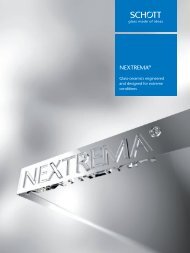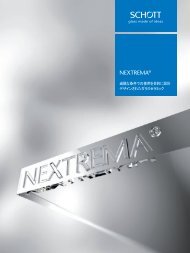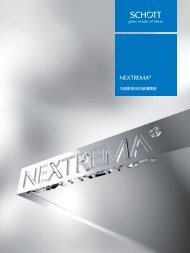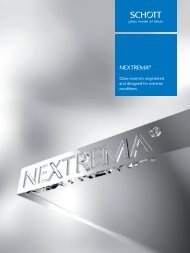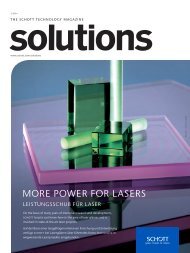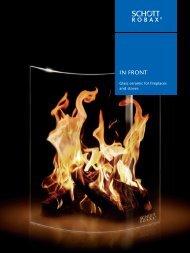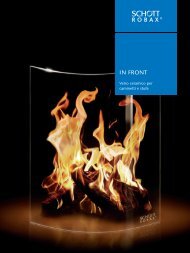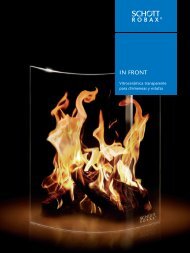SCHOTT Technical Glasses
Apart from its application in optics, glass as a technical material has exerted a formative influence on the development of important technological fields such as chemistry, pharmaceutics, automotive, optics, optoelectronics and information technology. SCHOTT Technical Glasses offers pertinent information in concise form. It contains general information for the determination and evaluation of important glass properties and also informs about specific chemical and physical characteristics and possible applications of the commercial technical glasses produced by SCHOTT. With this brochure, we hope to assist scientists, engineers, and designers in making the appropriate choice and make optimum use of SCHOTT products.
Apart from its application in optics, glass as a technical material has exerted a formative influence on the development of important technological fields such as chemistry, pharmaceutics, automotive, optics, optoelectronics and information technology. SCHOTT Technical Glasses offers pertinent information in concise form. It contains general information for the determination and evaluation of important glass properties and also informs about specific chemical and physical characteristics and possible applications of the commercial technical glasses produced by SCHOTT. With this brochure, we hope to assist scientists, engineers, and designers in making the appropriate choice and make optimum use of SCHOTT products.
You also want an ePaper? Increase the reach of your titles
YUMPU automatically turns print PDFs into web optimized ePapers that Google loves.
40<br />
8.5 Anti-reflective glasses for technical<br />
applications (CONTURAN ® /DARO)<br />
8.5.1. CONTURAN ®<br />
CONTURAN ® is an anti-reflective coating on both surfaces<br />
based on optical interference coatings, which can be used<br />
for technical applications i.e. front panels of visual display<br />
units, televisions, display panels, public displays.<br />
The multilayer coating is applied by way of a sol gel process<br />
that uses dip coating technology. As shown in Fig. 32a, three<br />
different layers are subsequently formed simultaneously on<br />
both surfaces of the glass. The refractive index of the layers<br />
is varied by the composition of the sol gel solution. SiO 2 is<br />
used as a low index material and TiO 2 for the high refractive<br />
index. In standard float glass, without an interference coating,<br />
about 8 % of light is reflected backwards to the observer<br />
(Fig. 32b, lower picture). The interference coating creates a<br />
design, which reduces reflecting light waves significantly.<br />
As shown in Fig. 32b, less than 1 % of light is now reflected.<br />
This reduction of the reflection leads to an enhanced contrast<br />
for pictures or displays behind CONTURAN ® cover plates.<br />
The coating is designed to reduce the reflection in the visual<br />
wavelength region of approximately 400 to 700 nm. Fig. 33<br />
shows the reflection curve for two distinctive coating designs<br />
used in the CONTURAN ® product portfolio. The “green<br />
hue” coating is a design used in standard optics. The “blue<br />
hue” coating yields a distinct residual blue reflection often<br />
desired in technical, design-oriented applications.<br />
Reflectance ρ in % ––><br />
10.0<br />
8.0<br />
6.0<br />
4.0<br />
2.0<br />
0.0<br />
425 450 475 500 525 550 575 600 625 650 675 700<br />
Wavelength in nm ––><br />
Clear float glass (standard) Green anti-reflective coating<br />
Blue-violet anti-reflective coating<br />
Fig. 33. Reflection spectrum of CONTURAN ® : Comparison of “blue hue”<br />
and “green hue” reflection<br />
8.5.2. Applications of CONTURAN ®<br />
Mineral-based cover plates are often used in display applications<br />
to protect the display from mechanical damage.<br />
However, the reflection of light on the glass reduces the<br />
contrast of the display, especially when used outdoors. One<br />
of the most obvious examples is the usage of smartphone<br />
outdoors, where the excellent display performance often is<br />
completely wiped out by the sunlight. CONTURAN ® with<br />
its low reflection is exactly designed to maintain the contrast<br />
of the display by reducing undesired reflections. Popular<br />
examples for applications are automotive displays, public<br />
displays and professional displays used for automatization.<br />
CONTURAN ®<br />
SiO<br />
Absorptance in the glass<br />
2<br />
~ 1 %<br />
TiO 2<br />
Exposure<br />
SiO 2 +<br />
to light<br />
TiO 2<br />
100 %<br />
Glass substrate<br />
SiO 2 +<br />
Transmittance<br />
TiO 2<br />
TiO 2<br />
> 98 %<br />
< 1 %<br />
Reflectance<br />
Standard float glass<br />
Absorptance in the glass<br />
~ 1 %<br />
Exposure<br />
to light<br />
100 %<br />
Transmittance<br />
~ 91 %<br />
~ 8 %<br />
Reflectance<br />
Fig. 32a. Three layer coating design<br />
Fig. 32b. Effect of anti-reflective coatings on the reflection of light






